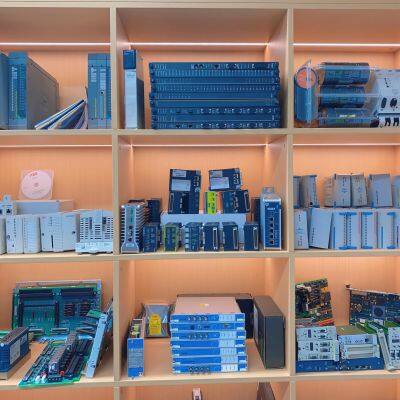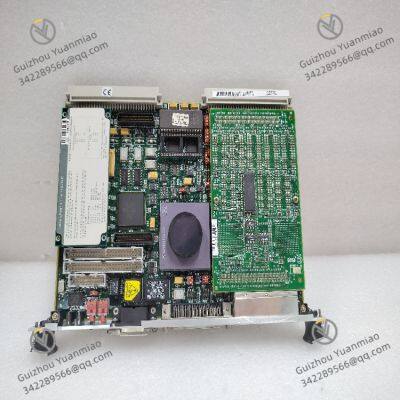Product Description
I. Core Configuration
(I) Processor Upgrade and Evolution
The early version of the MOTOROLA MVME172-533 adopted a 60MHz MC68060 microprocessor. With the continuous advancement of technology, subsequent versions were upgraded to a 1.2GHz PowerPC 7447A processor. This upgrade provides more sufficient processing capability for demanding applications, enabling it to easily handle both complex industrial automation control algorithms and operations requiring extremely high real-time performance and precision in the aerospace field. For example, in an industrial automation production line, when faced with the collection and analysis of large amounts of equipment status data and the rapid generation of control commands, the upgraded processor can efficiently complete tasks, ensuring the stable and high-speed operation of the production line.
(II) Flexible and Efficient Memory Configuration
The memory configuration of this controller is highly flexible. The initial configuration includes 4MB DRAM, 512KB SRAM, and 2MB Flash storage, which can meet basic operation and data storage needs. The upgraded version is equipped with 512MB DDR SDRAM, which has obvious advantages in data-intensive application scenarios. For instance, in the field of medical imaging, where a large amount of image data needs to be processed and stored quickly, the high-performance DDR SDRAM can achieve efficient memory access, greatly shortening the processing time of imaging data and improving imaging efficiency and quality.
(III) Rich Expansion Interfaces
The MVME172-533 is equipped with 4 IndustryPack ports and PMC expansion slots, which provide great convenience for its function expansion. According to actual needs, users can integrate additional I/O functions through these interfaces—such as increasing analog input and output channels to meet the collection and control of analog signals (e.g., temperature and pressure) in industrial automation; or integrating special processing functions, like adding signal processing modules to aerospace equipment to preprocess various sensor signals of aircraft and enhance the overall performance of the equipment.

II. Communication and Interfaces
(I) Ethernet Interfaces
It is equipped with an Ethernet transceiver interface with a 32-bit local bus DMA, ensuring high-speed data transmission capability. At the same time, it has three Gigabit Ethernet ports, which can meet the communication needs of large data volumes and high real-time performance. In the smart factory environment of Industry 4.0, a large number of devices need to conduct data interaction and collaborative work; the Gigabit Ethernet ports can realize fast data sharing between devices, such as real-time data transmission between equipment at various workstations on the production line, ensuring the smooth progress of the production process. In addition, it is also equipped with a 10/100BaseTX Ethernet interface, which can be compatible with devices that have low network speed requirements but need extensive connection, enhancing the versatility and network flexibility of the device.
(II) Serial Communication Interfaces
It supports 2 EIA-232-D serial ports, which are suitable for low-speed and short-distance device communication. In industrial automation, they are often used to connect debugging equipment, simple sensors, or actuators. For example, connecting small on-site temperature sensors to obtain temperature data provides basic data support for temperature control in the industrial production process.
(III) Other Interfaces
Two USB ports facilitate the connection of external storage devices or other USB-interfaced devices; for instance, during equipment maintenance and debugging, programs or data can be quickly copied through the USB ports. One parallel port can be used to connect devices (such as printers) that require parallel data transmission. Moreover, this controller supports multi-protocol fieldbus communication, including HART, FOUNDATION Fieldbus, and PROFIBUS PA. In the field of industrial automation, these fieldbus protocols are widely used in different control systems; the MVME172-533 can be compatible with multiple protocols, allowing it to be easily connected to various complex industrial networks and realize interconnection, intercommunication, and collaborative work with different devices.

III. Environmental Adaptability
(I) Operating Temperature Range
The standard model supports an operating environment of 0°C to 70°C, meeting the usage requirements of most industrial and commercial environments. For some special application scenarios—such as outdoor equipment, equipment in high-temperature workshops, or equipment in cold regions—the wide-temperature model can expand the operating temperature range to -40°C to +85°C. In oil extraction equipment in the energy field, the equipment may need to work in extremely cold outdoor environments; the wide-temperature model of the MVME172-533 can operate stably, ensuring that data collection and equipment control during oil extraction are not affected by low temperatures.
(II) Storage Temperature
The storage temperature covers the range of -40°C to 85°C, which means that even when the equipment is not in use for a long time and stored in a harsh environment, its internal electronic components and stored data can be effectively protected, and the equipment will not be damaged or data lost due to temperature issues.
(III) Physical Specifications
It adopts the standard 6U VMEbus size; this standardized size design enables it to be easily adapted to industrial-grade rack mounting. In the control cabinet of an industrial automation production line, it can be installed in accordance with the standard rack layout, which is neat and orderly, facilitating centralized management and maintenance of the equipment.
IV. Software and Ecosystem
(I) Operating System Support
It supports real-time operating systems such as VxWorks, LynxOS, and Linux. VxWorks is widely used in aerospace, industrial control, and other fields due to its high real-time performance and reliability; the combination of the MVME172-533 with VxWorks can ensure the stable operation and rapid response of the system in mission-critical scenarios. LynxOS also has excellent real-time performance and scalability, making it suitable for applications with extremely high system performance requirements. The Linux system, relying on its open-source nature, rich software resources, and good customizability, provides users with diversified development options. Users can select the most suitable operating system for development and deployment according to specific application requirements and development habits.
(II) Development Support
It provides a complete development toolchain, including compilers, debuggers, linkers, etc., which offers comprehensive support for developers in code writing, debugging, and optimization. At the same time, it is equipped with an application software library that contains various commonly used functional modules and interface functions (such as data collection and processing libraries, communication protocol libraries), which greatly shortens the development cycle and reduces development difficulty. In addition, this controller is compatible with a variety of existing software solutions; developers can make full use of existing software resources to further improve development efficiency and reduce development costs.
(III) Protocol Support
It integrates industrial protocol stacks such as FDT framework applications, HART communication DTM, and FOUNDATION Fieldbus configuration tools. The integration of these protocol stacks enables the MVME172-533 to better communicate and interact with various devices in industrial fields. In industrial automation systems, devices from different manufacturers may adopt different communication protocols; by integrating multiple industrial protocol stacks, the MVME172-533 can realize seamless connection with various devices and build a complete and efficient industrial control system.

V. Typical Application Scenarios
(I) Industrial Automation
As a production line controller, the MVME172-533 can monitor the operating status of various devices on the production line in real time and collect the operating data of the devices (such as the speed, temperature, and pressure of the equipment). Through the analysis and processing of these data, it realizes the optimized control of the production process. For example, in an automobile manufacturing production line, it can adjust the production rhythm in real time according to the assembly progress of parts and the status of equipment, improving production efficiency and product quality. At the same time, it can also provide early warning and diagnosis of equipment failures; when abnormal equipment parameters are detected, it will issue an alarm in a timely manner and take corresponding measures, reducing equipment downtime and production costs.
(II) Aerospace
In aircraft navigation systems, the MVME172-533 is responsible for processing signals from various sensors (such as gyroscopes and accelerometers), calculating information such as the attitude, position, and speed of the aircraft through complex algorithms, and transmitting this information to the flight control system in real time to ensure that the aircraft flies safely according to the scheduled route. In terms of on-board equipment control, it can centrally control and manage the aircraft's communication system, power system, and environmental control system, ensuring the normal operation of various systems of the aircraft. Its high reliability and excellent real-time performance meet the strict requirements for stable operation of equipment in extreme environments in the aerospace field.
(III) Harsh Environments
In the energy field—such as oil and natural gas extraction—equipment needs to work in harsh environments such as high temperature, high pressure, and strong electromagnetic interference. Relying on its strong anti-interference capability and wide-temperature adaptability, the MVME172-533 can stably collect data such as pressure and flow of wellhead equipment and accurately control the extraction equipment. In the transportation field—such as the signal control system of rail transit—equipment needs to operate reliably under complex electromagnetic environments and vibration conditions. The MVME172-533 can ensure the accurate transmission and control of signals, guaranteeing the safe operation of trains.


INDRAMAT MKD041B-144-KG1-KN MKD Synchronous Motors
KOLLMORGEN E22SSLT-LNN-NS-04 Step Motor
KOLLMORGEN E33NRHA-LNN-NS-00 Step Motor
Kollmorgen BJRL-20012-110001 Goldline Smart Drives
KOLLMORGEN AKM42E-EKGNR-01 Low Voltage Servo Motors
KOLLMORGEN CB06251 Servo Drives
KOLLMORGEN CR06200-000000 Controller Module
KOLLMORGEN DIGIFAS7201 Servo Amplifier
KOLLMORGEN PRD-P320260Z-C2 Servo Drives
INDRAMAT KDS1.3-150-300-W1 Servo Drive Module
INDRAMAT KDS1.3-200-300-W1 Servo Drive
IDEC PF3S-BP13 Pushbutton Module
 yezi
Hi there! Welcome to my shop. Let me know if you have any questions.
yezi
Hi there! Welcome to my shop. Let me know if you have any questions.





